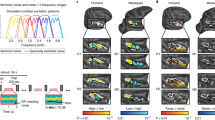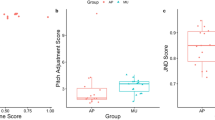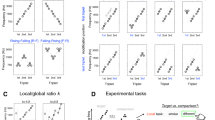Abstract
For over a century, models of pitch perception have been based on the frequency composition of the sound. Pitch phenomena can also be explained, however, in terms of the time structure, or temporal regularity, of sounds. To locate the mechanism for the detection of temporal regularity in humans, we used functional imaging and a 'delay-and-add' noise, which activates all frequency regions uniformly, like noise, but which nevertheless produces strong pitch perceptions and tuneful melodies. This stimulus has temporal regularity that can be systematically altered. We found that the activity of primary auditory cortex increased with the regularity of the sound. Moreover, a melody composed of delay-and-add 'notes' produced a distinct pattern of activation in two areas of the temporal lobe distinct from primary auditory cortex. These results suggest a hierarchical analysis of time structure in the human brain.
This is a preview of subscription content, access via your institution
Access options
Subscribe to this journal
Receive 12 print issues and online access
$209.00 per year
only $17.42 per issue
Buy this article
- Purchase on Springer Link
- Instant access to full article PDF
Prices may be subject to local taxes which are calculated during checkout





Similar content being viewed by others
References
von Helmholtz, H. L. F. On the Sensations of Tone (Longmans, London, 1885).
Patterson, R. D., Allerhand, M. H. & Giguerre, C. Time-domain modeling of peripheral auditory processing: a modular architecture and a software platform. J Acoust. Soc. Am. 98, 1890–1894 ( 1995).
Patterson, R. D. The sound of a sinusoid: Spectral models. J. Acoust. Soc. Am. 96, 1409–1418 (1994).
Cohen, M. A., Grossberg, S. & Wyse, L. A spectral network model of pitch perception. J. Acoust. Soc. Am. 98, 862–879 ( 1995).
Rose, J. E., Brugge, J. F., Anderson, D. J. & Hind, J. E. Phase-locked response to low-frequency tones in single auditory nerve fibres of the squirrel monkey. J. Neurophysiol. 30, 769– 793 (1967).
Patterson, R. D., Handel, S., Yost, W. A. & Datta, A. J. The relative strength of the tone and the noise components in iterated rippled noise. J. Acoust. Soc. Am. 100, 3286–3294 (1996).
Yost, W. A., Patterson, R. & Sheft, S. A time domain description for the pitch strength of iterated rippled noise. J. Acoust. Soc. Am. 99, 1066– 1078 (1996).
Rouilly, E., deRibaupierre, Y. & deRibaupierre, F. Phase-locked responses to low frequency tones in the medial geniculate body. Hear. Res. 213– 226 (1979).
Langner, G. & Schreiner, C. E. Periodicity coding in the inferior colliculus of the cat. I. neuronal mechanisms. J. Neurophysiol. 60, 1799–1822 ( 1988).
Pantev, C., Hoke, M., Lutkenhoner, B. & Lehnertz, K. Tonotopic organization of the auditory cortex: pitch versus frequency representation. Science 242, 486–488 ( 1989).
Penhune, V. B., Zatorre, R. J., MacDonald, J. D. & Evans, A. C. Interhemispheric anatomical differences in human primary auditory cortex: probabalistic mapping and volume measurement from magnetic resonance scans. Cereb. Cortex 6, 661–672 (1996).
Friston, K. J. Testing for anatomically specified regional effects. Hum. Brain. Mapp. 5, 133–136 (1997).
Merzenich, M. M. & Brugge, J. F. Representation of the cochlear partition on the superior temporal plane of the macaque monkey. J. Neurophysiol. 24, 193–202 (1973).
Rauschecker, J. F., Tian, B., Pons, T. & Mishkin, M. Serial and parallel processing in rhesus monkey auditory cortex. J. Comp. Neurol. 382, 89–103 (1997).
Pandya, D. N. Anatomy of the auditory cortex. Rev. Neurologique 151, 486–494 (1995).
Lauter, J. L., Herscovitch, P., Formby, C. & Raichle, M. E. Tonotopic organisation in the human auditory cortex revealed by positron emission tomography. Hear. Res. 20, 199–205 ( 1985).
Talavage, T. M., Ledden, P. J., Sereno, M. I., Rosen, B. R. & Dale, A. M. Multiple phase-encoded tonotopic maps in human auditory cortex. Neuroimage 5, S8 (1997).
Wessinger, C. M., Buonocore, M. H., Kussmaul, C. L. & Mangun, G. R. Tonotopy in human auditory cortex examined with functional magnetic resonance imaging. Hum. Brain Mapp. 5, 18– 25 (1997).
Phillips, D. P. & Farmer, M. E. Acquired word deafness and the temporal grain of sound representation in the primary auditory cortex. Behav. Brain Res. 40, 85–94 (1990).
Langner, G., Sams, M., Heil, P. & Schulze, H. Frequency and periodicity are represented in orthogonal maps in the human auditory cortex; evidence from magnetoencephalography. J. Comp. Physiol. 181, 665–676 (1997).
Peretz, I. et al. Functional dissociations following bilateral lesions of auditory cortex. Brain 117, 1283–1301 ( 1994).
Zatorre, R. J. & Halpern, A. R. Effect of unilateral temporal lobe excision on perception and imagery of songs. Neuropsychologia 31, 221–232 ( 1993).
Griffiths, T. D. et al. Spatial and temporal auditory processing deficits following right hemisphere infarction. A psychophysical study. Brain 120, 785–794 (1997).
Zatorre, R. J., Evans, A. C., Meyer, E. & Gjedde, A. Lateralization of phonetic and pitch discrimination in speech processing. Science 256, 846–849 ( 1992).
Zatorre, R. J., Evans, A. C. & Meyer, E. Neural mechanisms underlying melodic perception and memory for pitch. J. Neurosci. 14, 1908– 1919 (1994).
Platel, H. et al. The structural components of musical perception. A functional anatomical study. Brain 120, 229–243 (1997).
Friston, K.J. et al. Spatial registration and normalisation of images. Hum. Brain Map. 2, 165–169 ( 1995).
Talairach, P. & Tournoux, J. A Stereotactic Coplanar Atlas of the Human Brain (Thieme, Stuttgart, 1988).
Evans, A. C., Kamber, M., Collins, D. L., & Macdonald, D. in Magnetic Resonance Scanning and Epilepsy (eds Shorvon, S., Fish, D. Andermann, F., Bydder, G. M. & Stefan, H.) 263–274 (Plenum, 1994).
Friston, K.J. et al. Statistical parametric maps in functional imaging: a general linear approach. Hum. Brain Mapp. 2, 189– 210 (1995).
Acknowledgements
T.D.G., C.B. and R.S.J.F. are supported by the Wellcome Trust. R.D.P. is supported by the MRC (UK).
Author information
Authors and Affiliations
Corresponding author
Rights and permissions
About this article
Cite this article
Griffiths, T., Büchel, C., Frackowiak, R. et al. Analysis of temporal structure in sound by the human brain. Nat Neurosci 1, 422–427 (1998). https://doi.org/10.1038/1637
Received:
Accepted:
Issue Date:
DOI: https://doi.org/10.1038/1637
This article is cited by
-
The human amygdala disconnecting from auditory cortex preferentially discriminates musical sound of uncertain emotion by altering hemispheric weighting
Scientific Reports (2019)
-
Musical hallucinations and their relation with epilepsy
Journal of Neurology (2019)
-
Identifying musical pieces from fMRI data using encoding and decoding models
Scientific Reports (2018)
-
Prosodic processing post traumatic brain injury - a systematic review
Systematic Reviews (2017)
-
Functional neural changes associated with acquired amusia across different stages of recovery after stroke
Scientific Reports (2017)



